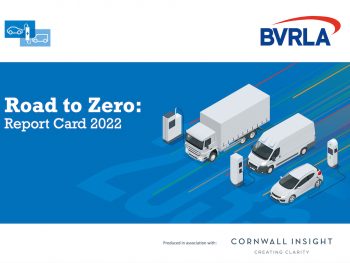Low company car tax still essential to fleet EV take-up, says BVRLA
Electric vehicle demand from fleets is strong but low Benefit-in-Kind tax rates remain vital in a fragile market.

The BVRLA says low BiK rates on electric company cars must be continued or EV take-up could stall
That’s one of the findings of the BVRLA’s new Road to Zero Report Card for 2022, which also warns that a one-size-fits-all approach to charging infrastructure is impeding the fleet sector’s journey towards decarbonisation.
Produced as an annual snapshot of the UK’s progress towards a sustainable future, the Report Card considers demand, supply and infrastructure for zero-emission cars, vans, and trucks respectively to identify what more can be done to achieve ambitious targets.
Now in its fourth year, the report recognises the diversity of the UK fleet sector and that the journey is proving more challenging for some segments than others.
For the car market, the report shows the sector is benefiting from fiscal incentives, ESG commitments and innovative mobility offerings, while order banks for electric vans are higher than ever, propped up by the Plug-in Van Grant.
And while demand for zero-emission HGVs starts from a lower base, it’s also accelerating as firms are giving serious thought into how they can transition effectively.
But there are concerns, not least a lack of insights into company car tax from 2025/6 and worries that the current low 2% BiK rate for EVs – seen as vital to their take-up – will be massively hiked up.
BVRLA chief executive Gerry Keaney said: “Electric vehicles are in high demand. Fleets remain committed to bringing cleaner, greener vehicles to UK roads and are delivering ambitious strategies to make it happen. The Government cannot rest on its laurels by taking that demand for granted. Incentives are making EVs cost effective, with low Benefit-in-Kind rates on electric company cars accelerating exceptional uptake. Those incentives must remain, otherwise the fragile market will stall in the face of severe economic headwinds.”
The BVRLA also warns that the landscape for charging infrastructure is improving but continues to trail behind, creating a ceiling that is stopping the high demand from becoming reality.
Widespread investment in the UK’s charging infrastructure has bolstered the opportunities for car drivers. Gaps remain for van operators, with concerns over vehicle downtime and inaccessible charge points yet to be addressed.
Keaney added: “Investment in charging infrastructure is not simply a numbers game. More consideration needs to be given to the needs of all road users. Fleet operators are ready to lead the charge but are being left with one hand tied behind their back. The government is beginning to listen to these concerns, and we will continue to push the issue until authorities across the country are building infrastructure strategies that fully meet fleet needs.”
For HGVs, the Report Card shows that infrastructure is ‘parked’, as a definitive powertrain roadmap still seems some way off. That lack of clarity is reducing confidence in the network and preventing operators from committing to the monumental investment that the move to zero emission vehicles requires.
An improving picture of eco credentials
In line with the BVRLA’s Road to Zero Report Card, the association has also published its sustainability credentials, showing BEV uptake and Clean Air Zone compliance across different fleet segments. These are constantly increasing and show how the fleet sector is leading the way in the electrification of the total UK car parc.
Salary sacrifice (55% of vehicles are BEV), car club (12%), and company cars (17%) have all seen their proportion of EVs increase vs 2021 figures. In the same period, the number of EVs in the car rental sector has more than doubled (from 0.6% to 1.5%).
The van sector has also made considerable gains from last year, but the overall proportion of the fleet able to go zero emission remains constrained by the supply and infrastructure issues highlighted in the Road to Zero Report Card. A total 1.8% of the leased LCV market is made up of zero-emission vans, up from 1% in 2021. That has seen the wider van parc grow from 0.3% to 0.7% zero emissions, showing the scope of the opportunity for further progress.
For more details on the BVRLA’s Road to Zero Report Card, click here.
The findings have been published as new research from Geotab also shows the impact of the UK’s lack of government incentives on EV take-up.
Its newly published analysis of the driving patterns of 46,000 connected internal combustion engine (ICE) vehicles from 17 countries found that 60% of analysed light-duty European fleet vehicles could be switched to fully electric vehicles today with a lower total cost of ownership and nearly a £218m overall saving.
But it also revealed that while daily fleet needs are more likely to be met by EVs in the UK, the financial benefits don’t stack up so well. Some 34% of vehicles were ‘range-capable’ but not economically viable – and this has increased following the ending of the Plug-in Car Grant. Only 55% of EV matches in the UK worked for both daily mileage range and financially savings – lower than Italy (71%), Spain (70%) and Germany (69%).

















